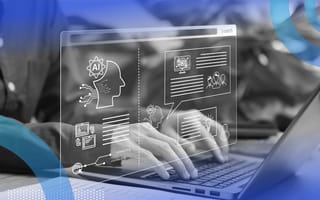While the arrival of AI agents promised a fully autonomous digital workforce, the reality is that the path to true, enterprise-grade AI has been far more complex than it seemed. The result has led companies to turn to the principle of human-in-the-loop — where people stay involved in and accountable for key workflows — as a temporary solution. Yet, instead of serving as a fading signal of human involvement, the principle is evolving.
Evolution of Human-in-the-Loop Explained
Human-in-the-loop is an AI principle that involves using an AI tool to complete a task with a human on hand to collaborate and oversee its execution for accuracy. As AI agents begin to operate with greater determinism, human-in-the-loop will evolve to focus less on oversight and more on innovative tasks using the insights AI provides.
And this evolution points to something more promising: human intelligence being amplified. Business leaders who embrace this shift see a future where humans and increasingly capable AI agents collaborate, where oversight, trust, and responsibility are shared, not surrendered.
Let’s explore how this transformation is unfolding.
Agentic AI Requires Relentless Accuracy
Picture an AI agent managing a complex, multi-step business process, like coordinating a global supply chain or resolving a multi-layered customer service issue. In these high-stakes environments, agentic AI must operate with deterministic precision. Because a single misstep, no matter how minor, can cascade into larger failures, amplifying risk, cost, and disruption across the entire system.
These aren’t small glitches. An incorrect inventory update, a misdirected shipment, or an inaccurate financial projection can flow through a company’s operations, affecting profitability, customer experience, and even regulatory standing. For AI agents to take on meaningful responsibility, every foundational action must be accurate and reliable. Trust in agentic AI hinges not just on intelligence, but on unwavering precision.
While generative AI excels at generating text, summarizing content and brainstorming ideas by predicting the most likely next word or concept, it is also unpredictable. In enterprise settings where precision is critical, “probably correct” isn’t good enough. Hallucinations, inconsistencies and limited explainability can undermine trust in generative AI outputs.
What Tasks Do AI Agents Excel At?
When generative AI’s probabilistic nature meets the precision of structured knowledge is where things get interesting. By grounding your AI agent with machine-readable, structured formats including enterprise taxonomies, ontologies and semantic knowledge graphs, organizations can offset generative AI’s non-determinism and drive more reliable results.
This structured foundation converts human-readable information into machine-actionable knowledge, the backbone of retrieval-augmented generation (RAG). When generative AI is paired with structured data, its outputs become more accurate, explainable, and predictable. Structured knowledge becomes a strategic asset.
It’s the combination of unstructured creativity fused with structured precision that paves the way for truly enterprise-ready AI.
But human involvement is still critical, and opens the door to more strategic opportunities for team members.
Evolution of Human-in-the-Loop
The evolution of human-in-the-Loop in AI is marked by a shift from basic oversight to more strategic roles. Initially, humans were involved in routine tasks such as data entry and basic monitoring. However, as AI technology has advanced, the role of humans has evolved.
In the current landscape, AI agents are increasingly capable of handling complex, multi-step business processes with a high degree of accuracy. However, the probabilistic nature of generative AI means that human oversight remains crucial, especially in high-stakes operations where precision is paramount. Humans are now tasked with intelligent oversight, which involves strategic monitoring, exception management and applying the kind of contextual judgment that AI still can’t match.
The integration of structured knowledge, such as enterprise taxonomies and knowledge graphs, has further enhanced the capabilities of AI agents, allowing them to operate with greater determinism. This structured approach helps enable AI agents to perform tasks with high confidence. Humans are now positioned to focus on strategic thinking, problem-solving, and innovation, while AI agents handle repetitive, data-intensive tasks. This partnership between humans and AI is expected to unlock new levels of productivity, quality and growth for organizations.
Even with major advances in accuracy and determinism, most organizations remain hesitant to entrust complex, high-stakes operations entirely to AI agents. Trust at this level doesn’t develop overnight. It takes time, real-world validation, and consistent performance before agentic AI can operate without human supervision.
In the meantime, humans will remain firmly in the loop. Rather than being phased out, human involvement is being elevated, to ensure AI operates within the boundaries of trust, safety and business intent.
Ultimately, agentic AI isn’t replacing humans — it’s amplifying them. Organizations that embrace this shift will unlock new levels of performance, insight, and competitive advantage. Those that don’t will be mired in cleaning up data while competitors redefine what’s possible.
Future of Humans in the Loop
While operational efficiencies will follow with agentic AI and humans in the loop, the real opportunity lies in enhancing human potential and driving enterprise-wide transformation.
The conversation around AI agents needs a reset. Rather than signaling the end of human involvement, the rise of agentic AI, especially when anchored by robust knowledge graphs, marks the beginning of a new era of human-AI collaboration. Our roles aren't being replaced; they're being elevated.
We’re moving from execution to strategic oversight, from routine tasks to nuanced judgment and creative problem-solving. For leaders prepared to embrace this intelligent partnership of human and machine, the opportunity is clear: to unlock new levels of efficiency, insight and innovation by combining the best of both.





